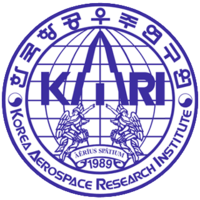| 한국항공우주연구원 | |
 | |
| Agency overview | |
|---|---|
| Abbreviation | KARI |
| Formed | 10 October 1989 |
| Type | Space agency |
| Headquarters | Daejeon, South Korea |
| Motto | Aerius Spatium[1] |
| Administrator | Lee Sang-Ryool[2] |
| Primary spaceport | Naro Space Center |
| Owner | National Research Council of Science & Technology |
| Annual budget | ₩615 billion (US$553.1 million) (FY2021)[3] |
| Website | Official KARI website in English Official KARI website in Korean |
| Korea Aerospace Research Institute | |
| Hangul | 한국항공우주연구원 |
|---|---|
| Hanja | |
| Revised Romanization | Hanguk Hanggong Uju Yeonguweon |
| McCune–Reischauer | Han'guk Hanggong Uju Yŏn'guwŏn |
The Korea Aerospace Research Institute (KARI; Korean: 한국항공우주연구원; Hanja: 韓國航空宇宙研究院; RR: Hanguk Hanggong Uju Yeonguweon), established in 1989, is the aeronautics and space agency of South Korea. Its main laboratories are located in Daejeon, in the Daedeok Science Town. KARI's vision is to continue building upon indigenous launch capabilities, strengthen national safety and public service, industrialize satellite information and applications technology, explore the Moon, and develop environmentally-friendly and highly-efficient cutting-edge aircraft and core aerospace technology. Current projects include the KSLV-2 launcher. Past projects include the 1999 Arirang-1 satellite. The agency was founded in 1989. Prior to South Korea's entry into the Institute for Advanced Engineering (IAE) in 1992, it focused primarily on aerospace technology. As of May 2024, KARI is an affiliated research institute of the Korea AeroSpace Administration.[4]
- ^ Latin for "Aerospace" "Archived copy". Archived from the original on 2011-09-27. Retrieved 2007-11-08.
{{cite web}}: CS1 maint: archived copy as title (link) - ^ "한국과학기술정보연구원, 한국항공우주연구원 신임 원장 선임". 22 March 2021.
- ^ "Government Finalizes the 2021 Space Development Implementation Plan". kari.re.kr. Retrieved 2021-12-18.
- ^ 배민영 (8 January 2024). "'한국판 나사' 우주항공청, 과기부에 설치… 항우연·천문연도 편입". Segye Ilbo (in Korean). Retrieved 4 June 2024.